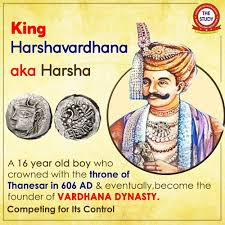King Harshavardhana of Sthanesvaram who ruled over the whole of North India from A.D. 606 to 648 is the author of Naganandam. Apart from being the Emperor of a great kingdom extending from the Himalayas to the Narmada river and from Sourashtra to Brahmaputra, Harshavardhana was himself a poet and a patron of learning. MahaKavis like BanaBhatta, Kumaradasa and Dharmakirti were some of the famous authors who adorned his court and Bana also wrote his patron’s biography in excellent prose in the work called Harshacaritam. The Chinese pilgrim Hieun Tsing stayed in Harsha’s court for a long time and became intimate with the emperor.
Harshavardhana or Harsha
Deva as he is commonly known in literature has authored three dramas - Priyadarsika,
Ratnavali and Naganandam. The first
two plays are modelled after the play Malavikagnimitram of Kalidasa and are
based on the legend of Vatsa Raja Udayana and Vasavadatta.
The best and perhaps the
last work was Naganandam written when the author began to have learnings
towards the tenets of Buddhism. The
Chinese traveller, Tsing has referred to this work thus - “King Siladitya
versified the story of Bodhi Satva Jimutavahana who surrendered himself in
place of a Naga. He had it performed by
a band accompanied by dancing and acting and thus popularised it in his time”.
BanaBhatta
Banabhatta
was earliest prose writer. He was the writer of Harshacaritam
and Kadambari.
He was a
court poet of King Harsha. He
belongs to the first half of the 7th Century A.D. After
his return to his village from pilgrimage, he wrote Harshacaritam partly autobiographical and partly biographical.
Of the two prose works of Bana, Harshacaritam must have been
the earlier composition. It has eight chapters. Having given an account of
himself Bana traces Harshavardhana’s ancestry to a King called Prabhakaravardhana.
He then deals with the life of Prabhakaravardhana and his two sons Rajyavardhana
and Harshavardhana and his daughter Rajyashri. The work abruptly ends with Harshavardhana placing
his widowed sister
under the care of a Buddhist
monk and leaving the place to wreak vengeance
against the King of Gowdas,
the killer of his brother. What made Bana desist from
proceeding further from the story is not known.
The other work Kadambari is found to be later
production. This abrupt ending may be because of Harsha’s leanings to Buddhism
was not tolerated by Bana or the defeat inflicted on his patron by Pulakesin II, was not desired to be recorded. Bana must have referred to this if he had completed the work.
This is only a conjecture not
supported by any external evidences.
Kadambari
is a romance treating the life of two couples namely Kadambari and Chandrapida
and Mahasvetha and Pundarika. As a literary work, Kadambari
is superior to Harshacharitham. On Kada-mbari in particular, Bana has
spent all his wealth of observation and fullness of imagery. Through his work
is based on Brhatkatha by Gunadhya, the author has a full scope to display his
talent. Bana’s style is referred to as Panchali style. He exhibits great skill in characterisation. He has used to perfection not only the well-known figures of speech like Upama, Rupakam,
Uthpreksha etc., but also difficult ones like Virodhabasa, Akshepa, Vakrokti
etc.
Traditional Pundits who have acquired
a good grounding in Sanskrit language have appreciated in the following manner - “Baanocchishtam
Jagat sarvam, “Kadambari rasajnaanaam Aahaaropi na rochathe”.





No comments:
Post a Comment